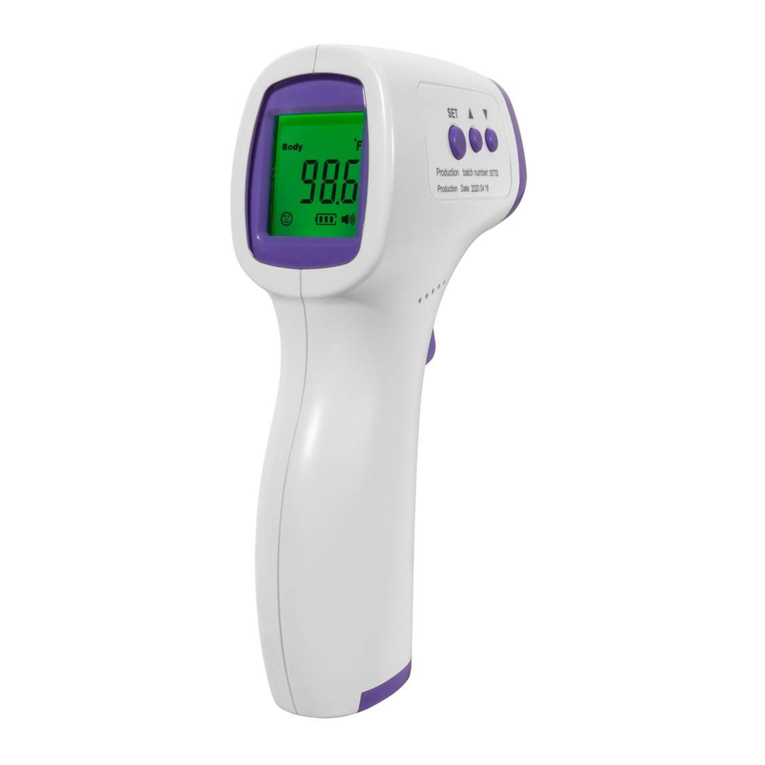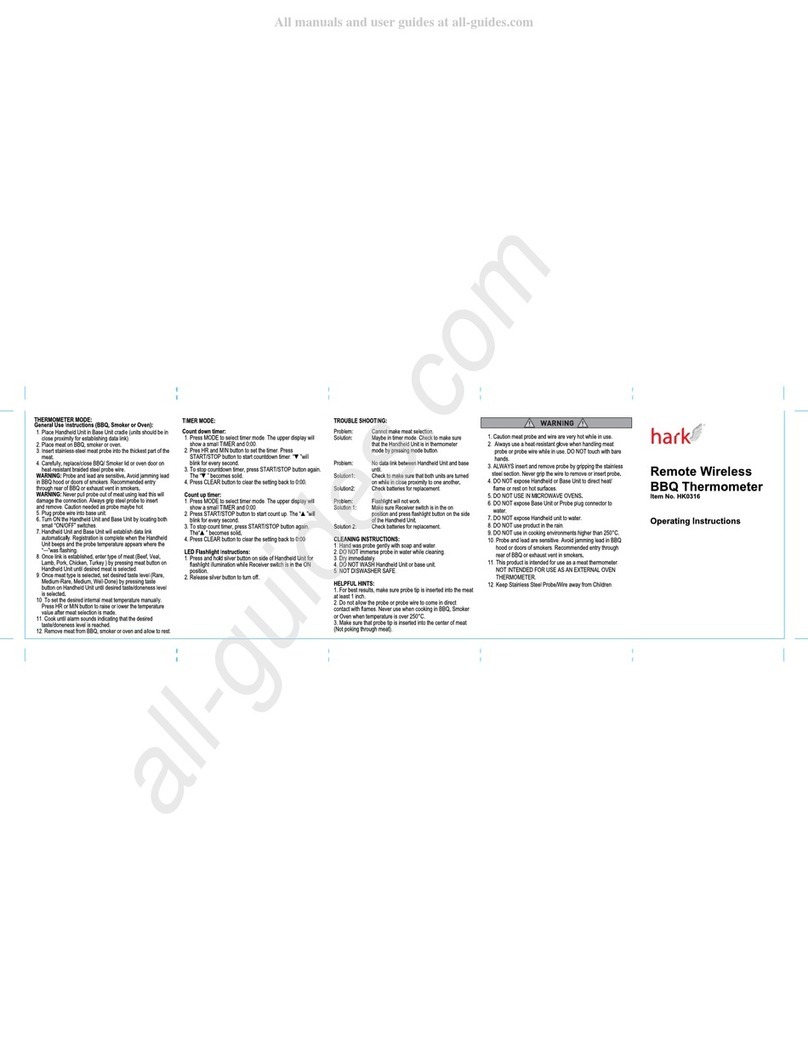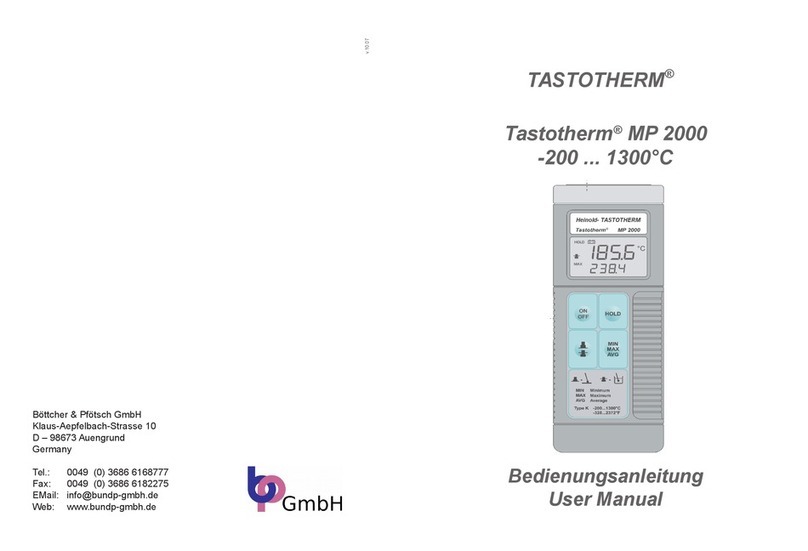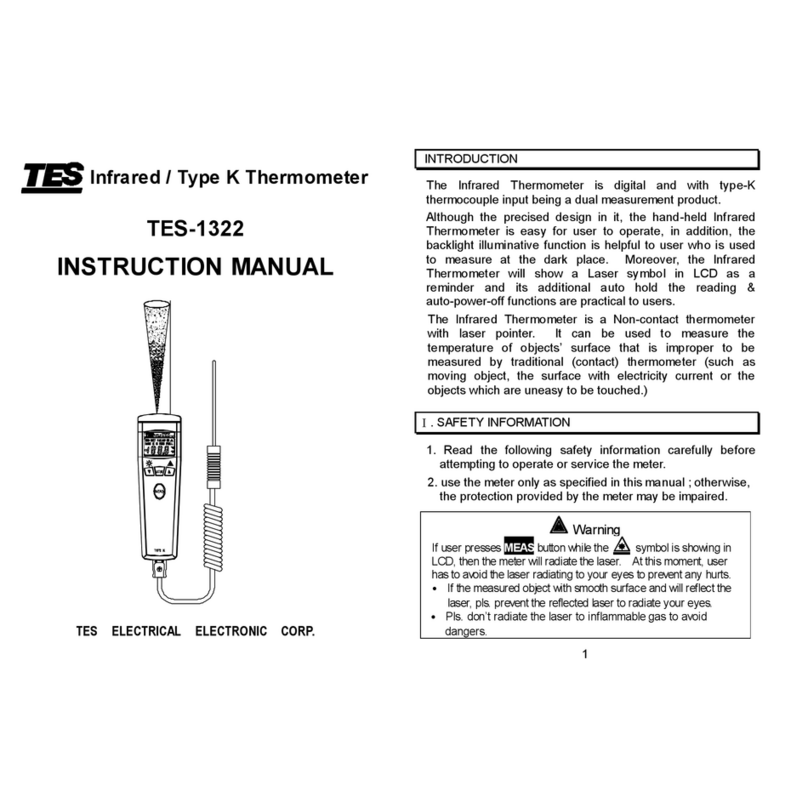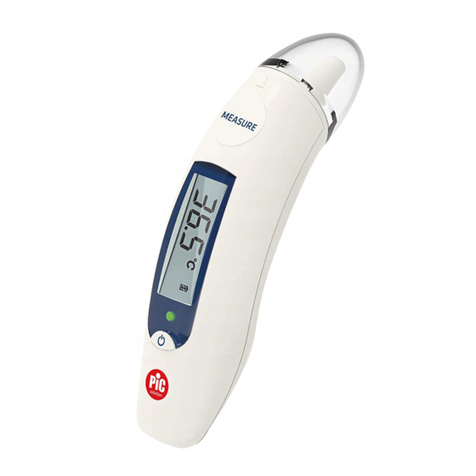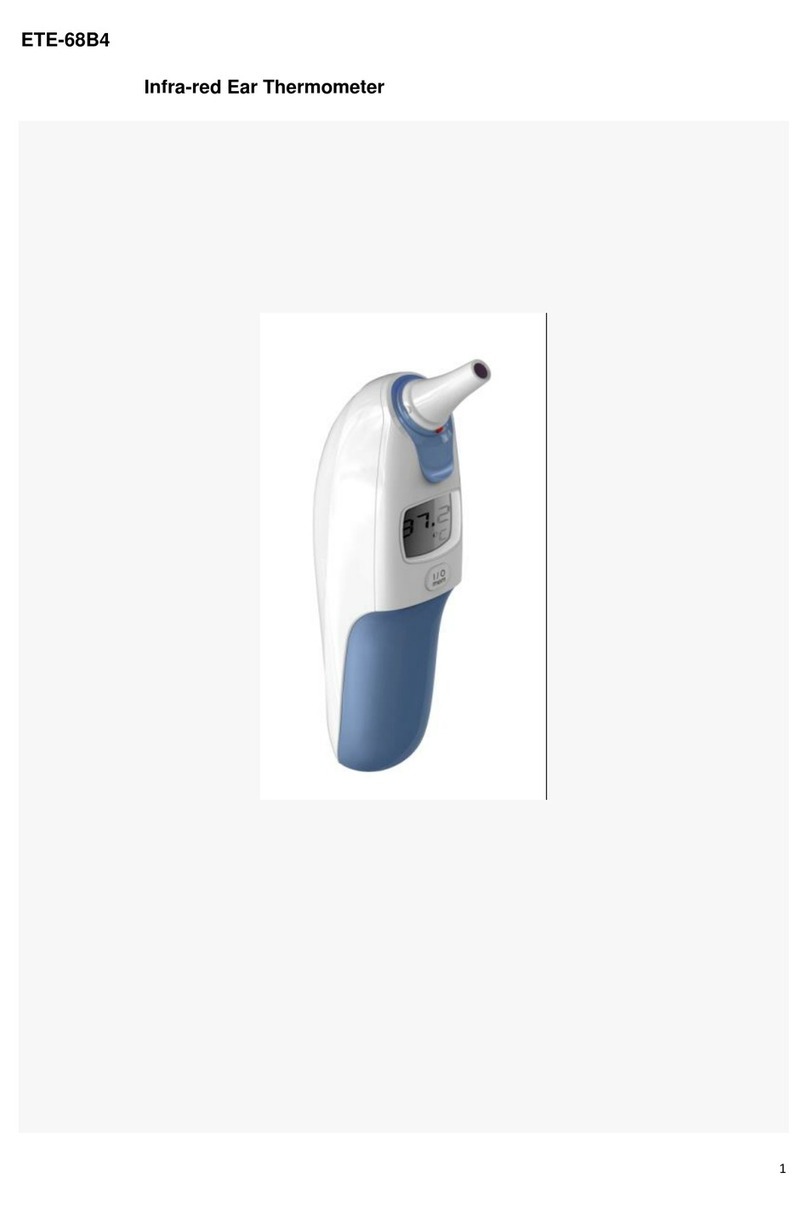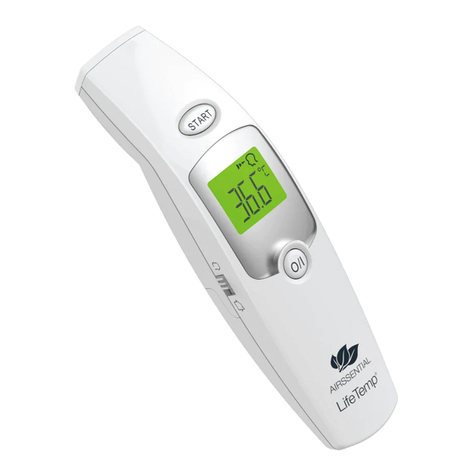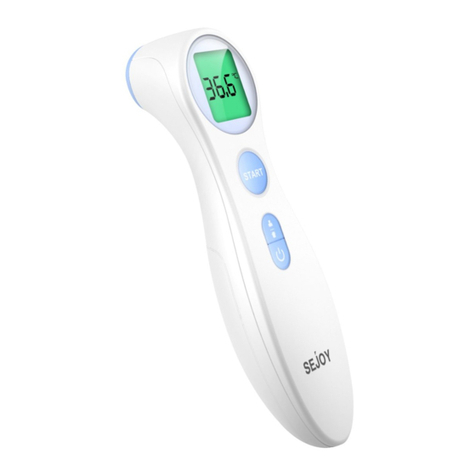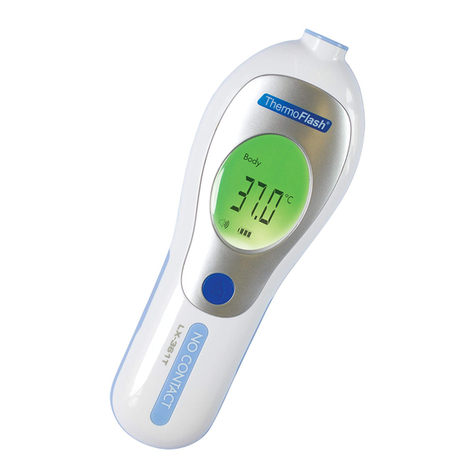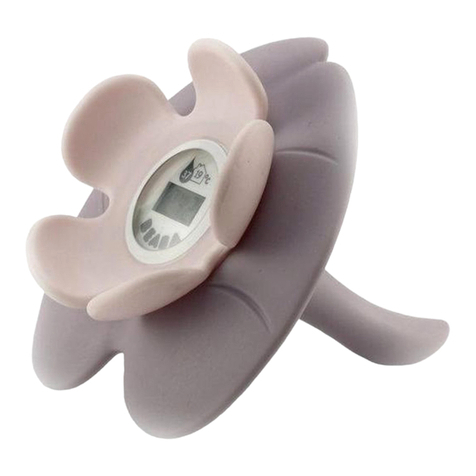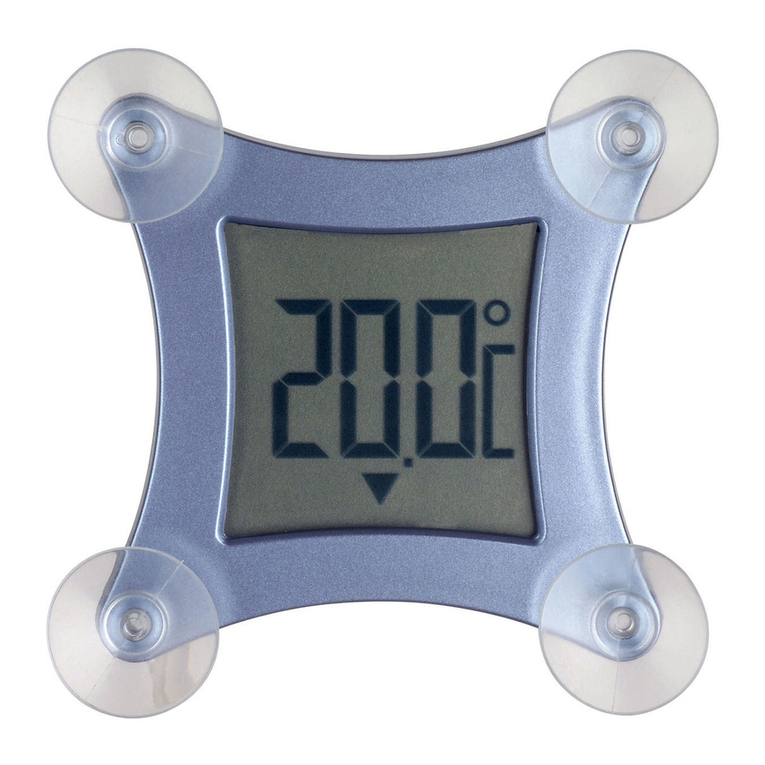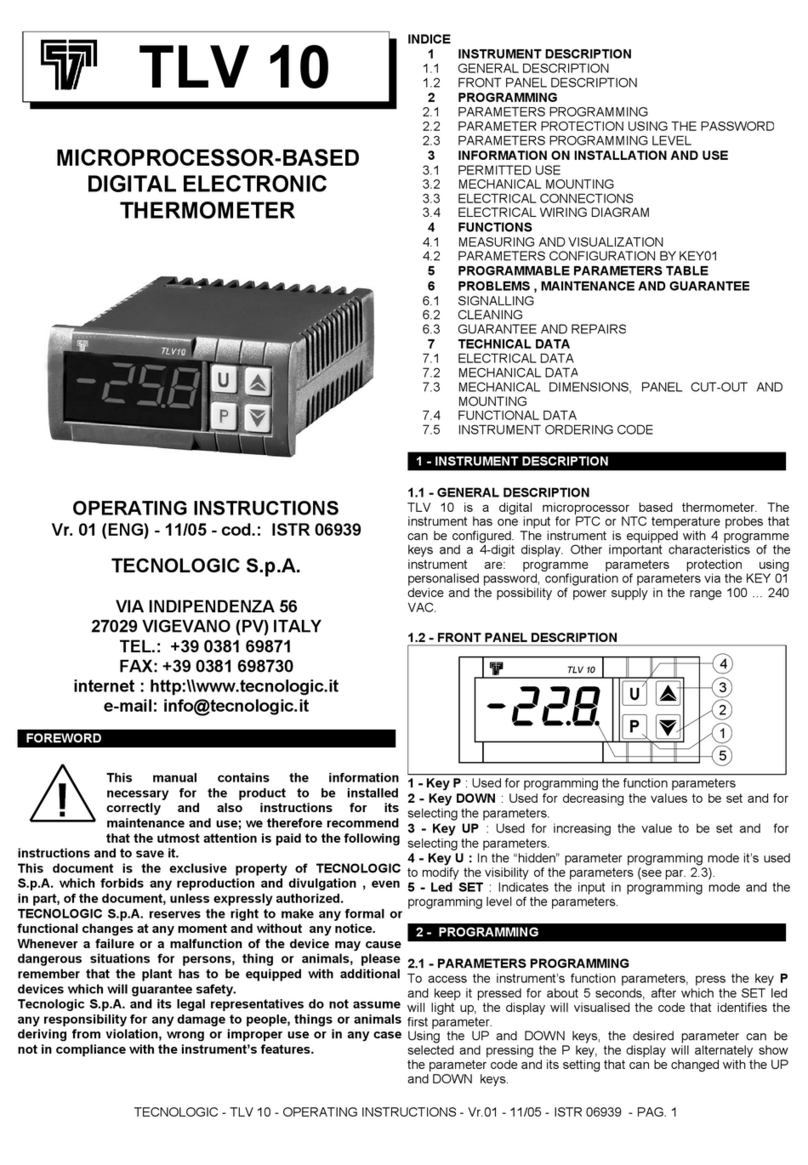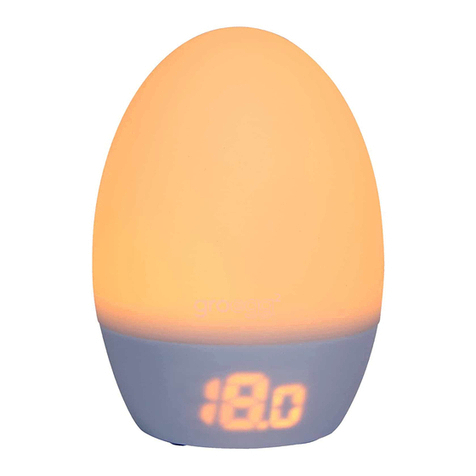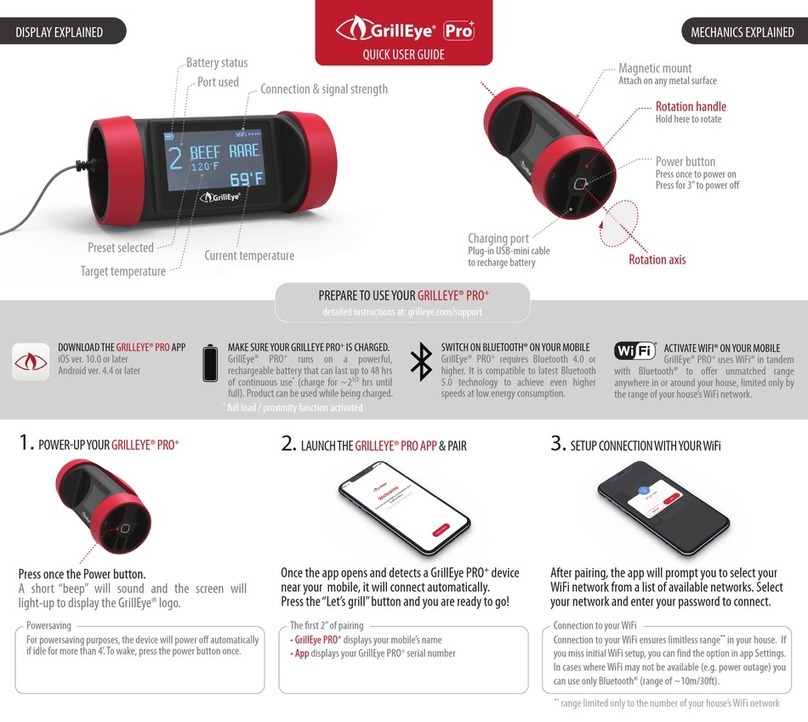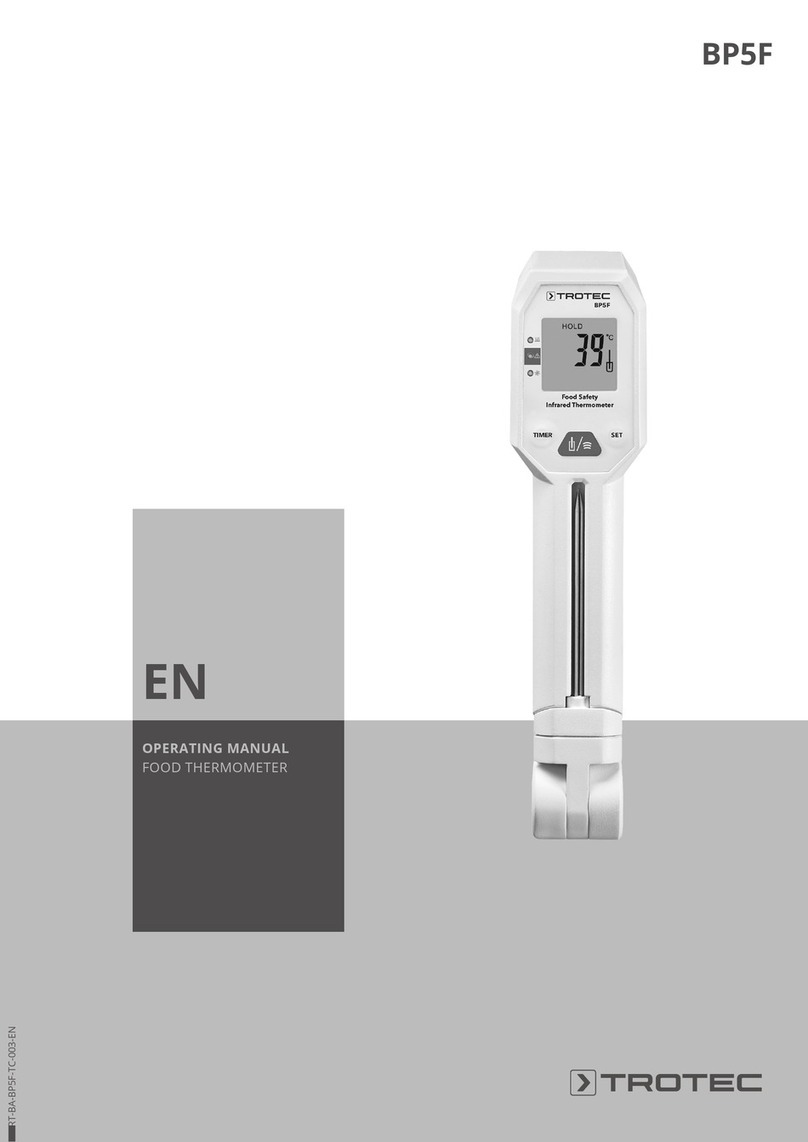Escali BT601 User manual

Ear and Forehead
Thermometer
Model # BT601
www.escali.com
V.08.31.2020
PRODUCT
MANUAL

2
WARNINGS AND PRECAUTIONS
1. Keep out of reach of children under 12 years.
2. Never immerse the thermometer into water or other liquids (not waterproof). For cleaning and disinfect-
ing, please follow the instructions in the “Care and cleaning” section.
3. Never use the thermometer for purposes other than those it has been intended for. Please follow the
general safety precautions when using on children.
4. Keep the thermometer away from direct exposure to the sun and keep it in a dust- free, dry area, well-
ventilated place at a temperature between 50 ºF (10ºC) - 104ºF (40ºC) . Do not use the thermometer in
high humidity environments. (>95% RH)
5. Do not use the thermometer if there are signs of damage on the measuring sensor or on the instru-
ment itself. If damaged, do not attempt to repair the instrument! Please contact the dealer.
6. This thermometer consists of high-quality precision parts. Do not drop the instrument. Protect it from
severe impact and shock. Do not twist the instrument or the measuring sensor.
7. Please consult your doctor if you see symptoms such as unexplained irritability, vomiting, diarrhea,
dehydration, changes in appetite or activity, seizure, muscle pain, shivering, stiff neck, pain when uri-
nating, etc., even in the absence of fever.
8. Even in the absence of fever, those who exhibit a normal temperature may still need to receive medical
attention. People who are on antibiotics, analgesics, or antipyretics should not be assessed solely on
temperature readings to determine the severity of their illness.
9. Temperature elevation may signal a serious illness, especially in adults who are old, frail, have a weak-
ened immune system, or neonates and infants. Please seek professional advice immediately when
there is a temperature elevation and if you are taking temperature for whom are:
• Over 60 years of age (Fever may be blunted or even absent in elderly patients)
• Having diabetes mellitus or a weakened immune system (e.g., HIV positive, cancer, chemo-
therapy, chronic steroid treatment, splenectomy)
• Bedridden (e.g., nursing home patient, stroke, chronic illness)
• A transplant patient (e.g., liver, heart, lung, kidney)
10. This thermometer is not intended for preterm babies or small-for-gestational age babies. This ther-
mometer is not intended to interpret hypothermic temperatures. Do not allow children to take their
temperatures unattended.
11. Use of this thermometer is not intended as a substitute for consultation with your physician or pediatri-
cian.
12. Clean the thermometer probe after each use.
13. Do not use the thermometer on newborns or for continuous temperature monitoring purposes.
14. Do not take a measurement while or immediately after nursing a baby.
15. Patients should not drink, eat, or be physically active before/while taking the measurement.
DISPLAY DESCRIPTION
1. Adult forehead mode
2. Child forehead mode
(under 12 years old)
3. Ear mode
4. Object mode
5. Fahrenheit / Celsius degrees
6. Previous temperature value
7. Low battery indication
8. Mute /Un-mute icon
9. Current temperature value
HOW TO USE YOUR THERMOMETER
In order to avoid inaccurate measurements:
1. Please make sure that the device will be used indoors only and there are no strong gusts of wind pre-
sent at the time of measurement.
2. Please make sure that there is no intense motion or movement before measuring.
3. If the device is transferred from one condition to another, which has different ambient temperature, it is
suggested to wait at least 30 minutes before measuring temperature.

3
4. If the person to be measured has transferred from one location to another, which has different ambi-
ent temperature, it is suggested to wait at least 10 minutes before taking their temperature.
5. Do not hold the device for a long time, as it is highly sensitive to heat.
6. The device has undergone clinical test, it is safe and accurate when using in accordance with opera-
tion manual.
HOW TO TAKE YOUR FOREHEAD TEMPERATURE
1. When using the thermometer for the first time, please load the batteries.
2. Press and release the Thermometer (measure/mute) button for one second to power on. Press the
M (mode/memory) button to choose or . Then point the temperature probe at the center of the
forehead, with a distance of 0-3 cm (0-1.18 inches).
3. Press and release the Thermometer (measure/mute) button. The beep is heard, you can now read
the value.
NOTE: The forehead measurement is an indicative reading. The measured forehead temperature can
fluctuate up to 1 ºF (0.5 ºC) from your actual body temperature. Please be aware of the factors that influ-
ence the accuracy as described in the section “TEMPERATURE TAKING TIPS” and “WARNINGS AND
PRECAUTIONS” .
If the eyebrow area is covered with hair, sweat or dirt, please clean the area beforehand to improve the
reading accuracy.
Always check if the lens is clean.
Always make sure the user and the thermometer will have been in the same room for at least 30 minutes
prior to the measurement.
HOW TO TAKE YOUR EAR TEMPERATURE
1. Press the Thermometer (measure/mute) button to power on.
2. Press the M (mode/memory) button to choose and take off the probe
cover (if with magnetic probe cover, it is automatically switched between
forehead & ear mode), fit the probe snuggly into the ear canal.
3. Press and release the Thermometer (measure/mute) button, the beep is
heard, you can now read the value.
Please make sure that the ear is clean, with no earwax or obstructions.
The right ear reading may differ from the reading taken at the left ear. There-
fore, always take the temperature in the same ear.
Note:
Children under 1 year: Pull the ear straight back.
Children aged 1 year to adult: Pull the ear up and back.
Do not force the thermometer into the ear canal. Otherwise, the ear canal may get injured.
When taking the temperature on an adult, gently pull the ear up and back to make sure the ear canal is
straight, so that the temperature probe can receive an infrared ray from the eardrum.
Be careful when taking temperature on a child, whose ear canal is small.
AFTER TAKING A MEASUREMENT
Once the measurement is complete, remove the thermometer away from the forehead/ear and observe the
temperature.

4
After each measurement, you can enter the memory recall mode and query earlier temperature readings.
Do not hold the thermometer for a long time, because it is sensitive to the ambient temperature.
After each measurement, clean the temperature probe with a soft cloth, and put the thermometer in a dry
and well-ventilated place.
You should wait at least 10 seconds between each measurement.
It is dangerous to make a self-diagnosis or self-treatment based on the obtained measurement results. For
such purposes, please consult a doctor.
HOW TO READ YOUR TEMPERATURE
T indicates a temperature reading.
In forehead mode:
If 89.6ºF ≤ T ≤ 99.5ºF (32ºC ≤ T ≤ 37.5ºC), the green light will be displayed, with one long beep.
If 99.7ºF ≤ T ≤ 100.4ºF (37.6ºC ≤ T ≤ 38.0ºC), the orange light will be displayed with 6 short beeps, which is
a warning that you may have a low fever.
If 100.6°F ≤ T ≤ 109.2°F (38.1ºC ≤ T ≤ 42.9ºC), the red light will be displayed with 6 short beeps, which is a
warning that you may have a high fever.
In object mode:
If 32.0ºF ≤ T ≤ 199.0ºF (0ºC ≤ T ≤ 100ºC), the white light will be displayed with one long beep.
HOW TO MUTE AND UNMUTE THE THERMOMETER
When the thermometer is turned on, keep pressing the Thermometer (measure/mute) button for 5 sec-
onds, to switch from un-mute to mute.
CHECKING THE 40 SETS OF MEMORY DATA
When the thermometer is turned on or off, keep pressing the M (mode/memory) button for 5 seconds to go
to the memory mode, press this button again to check the 40 sets of memories one by one. If no value, it will
display “---”.
ºC / ºF CONVERSION
Open the battery cover, use the toggle switch to change the ºC/ ºF.
AUTOMATIC OFF
The unit will shut down automatically after 13 seconds of no use.
BATTERY REPLACEMENT CAUTION
All memory records will be lost when you uninstall or reinstall the batteries.
HOW TO REPACE THE BATTERIES
Put two AAA batteries correctly into the compartment.
Remove the batteries if the thermometer will not be used for more than two months.
TEMPERATURE TAKING TIPS
1. It is important to know each individual’ s normal temperature when they are well. This is the only way
to accurately diagnose a fever. Record readings twice a day (early morning and late afternoon). Take
the average of the two temperatures to calculate normal oral equivalent temperature. Always take the
temperature in the same location, since the temperature readings may vary from different locations on
the forehead.
2. A child’s normal temperature can be as high as 99.9ºF ( 37.7ºC ) or as low as 97.0ºF ( 36.1ºC ).
Please note that this unit reads 0.9ºF (0.5ºC) lower than a rectal digital thermometer.
3. External factors may influence ear temperatures, including when an individual has:
• been lying on one ear or the other
• had their ears covered
• been exposed to very hot or very cold temperatures
• been recently swimming or bathing
In these cases, remove the individual from the situation and wait 20 minutes prior to taking
a temperature.

5
Use the untreated ear if prescription ear drops or other ear medications have been placed
in the ear canal.
4. Holding the thermometer for too long in the hand before taking a measurement can cause the device
to warm up. This means the measurement could be incorrect.
5. Patients and the thermometer should stay in a room with a steady environment for at least 30 minutes.
6. Before placing the thermometer sensor onto the forehead, remove dirt, hair, or sweat from the fore-
head area. Wait 10 minutes after cleaning before taking measurement.
7. Use an alcohol swab to carefully clean the sensor and wait for 5 minutes before taking a measurement
on another patient. Wiping the forehead with a warm or cool cloth may impact your reading. It is ad-
vised to wait 10 minutes before taking a reading.
8. In the following situations it is recommended that 3-5 measurements in the same location be taken and
the highest one taken as the reading:
• New-born infants in the first 100 days.
• Children under three years of age with a compromised immune system and for whom the
presence or absence of fever is critical.
• When the user is learning how to use the thermometer for the first time until he/she has
familiarized himself/herself with the instrument and obtains consistent readings.
CARE AND CLEANING
Use an alcohol swab or cotton swab moistened with 70% alcohol to clean the thermometer casing and the
measuring probe. After the alcohol has completely dried out, you can take a new measurement.
Ensure that no liquid enters the interior of the thermometer. Never use abrasive cleaning agents, thinners or
benzene for cleaning and never immerse the instrument in water or other cleaning liquids. Take care not to
scratch the surface of the LCD screen.
ERROR AND TROUBLESHOOTING
Symptom Possible Cause Descripon & Soluon
The baery level is too low. Replace with a new baery.
Failed to power on. Polaries of the baeries are re-
versed.
Ensure the baeries are in the right posion.
The thermometer is damaged. Contact Escali.
The lens of the probe is dirty. Clean the lens with a coon swab.
The reading is too
high.
The distance of the item and target
is too far.
Keep in contact with forehead, or put the probe
into the Ear Canal.
You have just come from a cold
environment.
Stay in a warmer room for at least 30 minutes
before taking a reading.
The ambient temperature is not in
operable range.
One long beep, and red backlit for 3 seconds.
Take a measurement under an ambient temper-
ature between 50.0°F (10°C) and 104°F (40°C).
Memory error or calibraon is not
nished. Item will be turned o
automacally aer 3 seconds.
One long beep, and red backlit for 3 seconds.
Contact Escali.
In ear or forehead mode, T > 109.2°F
(42.9°C). In object mode, T > 199°F
(100°C).
One long beep, the screen will be displayed in
red.

6
Symptom Possible Cause Descripon & Soluon
In ear or forehead mode, T < 89.6°F
(32°C). In object mode, T < 32°F (0°C).
One long beep, the screen will be displayed in
red.
The power voltage is between 2.4V—
2.7V
The baery icon will icker, it means the baery
is low, but you can use the thermometer.
The power voltage is between 2.4V—
2.7V
The baery icon will icker, the item will be
turned o automacally aer 3 seconds. Please
replace with a new baery.
Product name Forehead & Ear infrared thermometer
Applicable regula-
ons and laws
ASTM E 1965-98 (Re-approved 2016) Standard Specicaon for Infrared Thermometers for
Intermient Determinaon of Paent Temperature
ISO80601-2-56 First Edion 2009-10-01 Medical Electrical Equipment - Part 2-56: Parcular
Requirements For Basic Safety And Essenal Performance Of Clinical Thermometers For
Body Temperature Measurement. (General Plasc Surgery/General Hospital)
Display Segment LCD, Four color LED backlight (white, green, orange, red)
Temperature units °C / °F, switchable
Power supply DC 3V, AAAX2
Measurement
range
Forehead & Ear: 32.0°C–42.9°C (89.6°F–109.2°F)
Object: 0°C–100°C (32°F–199°F)
Accuracy
(Laboratory)
Ear & Forehead mode ±0.2°C/±0.4 °F
Object mode ±1.0°C / 2.0°F ±1.0°C / 2.0°F
Display resoluon 0.1ºC / °F
Automac 13s±1s
shutdown Memory 40 groups of measured temperature.
Operaonal
condions
Temperature:10°C-40°C(50°F-104°F) Humidity: 15-95%RH, non-condensing Atmospheric
pressure:70-106kPa
Storage condion Ambient Temperature: -20°C-55°C(-4°F-131°F) Relave Humidity: 0-95% RH, non-condensing
Atmospheric pressure: 50kPa to 106kPa
Baery 2*AAA, can be used for more than 3000 mes
Weight & Dimen-
sion 60g (without baery), 143x35x41mm
10. Technical Specifications:

7
11. Symbols:
Symbol Forehead & Ear infrared thermometer
Type BF applied part.
Informaon about a manufacturer.
Please read the instrucons carefully.
Waste electrical materials should be sent to a dedicated collecon point for recycling.
Serial number
Batch number
IMPORTANT
Inaccurate reading or thermometer damage may occur if the thermometer is not Correctly
used.
2 Protected against solid foreign objects of 12,5 mm Ø and greater:
2 If keep the thermometer in 15 degree angle, it sll can prevent the water drop.
12. Appendix: EMC information-Guidance and manufacturer’ s declarations
CAUTION :
• The Infrared Thermometer needs special precautions regarding EMC and needs to be
installed and put into service according to the EMC information provided for in the AC-
COMPANYING DOCUMENTS.
• Portable and mobile RF communications equipment can affect Infrared Thermometer
• The Infrared Thermometer should not be used adjacent to or stacked with other equip-
ment. Guidance and manufacturer´s declaration – electromagnetic emission –for all
EQUIPMENT AND SYSTEMS

8
Guidance and manufacturer's declaration – electromagnetic immunity –for all EQUIPMENT and
SYSTEMS
Guidance and manufacturer´s declaraon – electromagnec emission
The Infrared Thermometer is intended for use in the electromagnec environment specied below. The customer or
the user of the Infrared Thermometer should assure that it is used in such an environment.
Immunity test Compli-
ance level
Electromagnec environment - guidance IEC 60601
test level
Electrostac
discharge (ESD)
IEC 61000-4-2
±8 kV
contact
±15 kV air
Floors should be wood, concrete or ceramic le. If oors are covered
with synthec material, the relave humidity should be at least 30 %.
±8 kV
contact
±15 kV air
Power frequency
(50/60Hz) mag-
nec eld IEC
61000-4-8
30 A/m Power frequency magnec elds should be at levels characterisc of
a typical locaon in a typical commercial or hospital environment.
30 A/m
Guidance and manufacturer´s declaraon – electromagnec emission
The Infrared Thermometer is intended for use in the electromagnec environment specied below. The customer
or the user of the Infrared Thermometer should assure that it is used in such an environment.
Emissions Compliance Electromagnec environment - guidance
test RF emissions
CISPR 11
Group 1 The Infrared Thermometer uses RF energy only for its internal funcon. There-
fore, its RF emissions are very low and are not likely to cause any interference in
nearby electronic equipment.
RF emissions
CISPR 11
Class B The Infrared Thermometer is suitable for use in all establishments, including
domesc establishments and those directly connected to the public low-voltage
power supply network that supplies buildings .

9
Guidance and manufacturer´s declaraon – electromagnec immunity
The Infrared Thermometer is intended for use in the electromagnec environment specied below. The customer
or the user of the Infrared Thermometer should assure that it is used in such an environment.
Immunity test IEC 60601
test level
Compli-
ance level
Electromagnec environment - guidance
Radiated RF
IEC 61000-4-3
3 V/m 80
MHz to 2.5
GHz
10V/m
Portable and mobile RF communicaons equipment should be used
no closer to any part of the Infrared Thermometer, including cables,
than the recommended separaon distance calculated from the
equaon applicable to the frequency of the transmier. Recommend-
ed separaon distance
\Where p is the maximum output power rang of the transmier in
was (W) according to the transmier manufacturer and d is recom-
mended separaon distance in meters (m).b Field strengths from
xed RF transmiers, as determined by an Electromagnec site sur-
vey, a should be less than the compliance level in each frequency
range. Interference may occur in the vicinity of equipment marked
with the following symbol:
NOTE 1 At 80 MHz and 800 MHz, the higher frequency range applies.
NOTE 2 These guidelines may not apply in all situaons. Electromagnec is aected by absorpon and reecon
from structures, objects and people.
80 MHz to 800 MHZ
800 MHz to 2,5 GHz
a. Field strengths from xed transmiers, such as base staons for radio (cellular/cordless) telephones and land
mobile radios, amateur radio, AM and FM radio broadcast and TV broadcast cannot be predicted theorecally with
accuracy. To assess the electromagnec environment due to xed RF transmiers, an electromagnec site survey
should be considered. If the measured eld strength in the locaon in which the Infrared Thermometer is used ex-
ceeds the applicable RF compliance level above, the Infrared Thermometer should be observed to verify normal
operaon. If abnormal performance is observed, addional measures may be necessary, such as re-orienng or
relocang the Infrared Thermometer.

10
Recommended separaon distances between portable and mobile RF communicaons equipment and the Infrared
Thermometer.
The Infrared Thermometer is intended for use in an electromagnec environment in which radiated RF disturbances
are controlled. The customer or the user of the Infrared Thermometer can help prevent electromagnec interference
by maintaining a minimum distance between portable and mobile RF communicaons equipment (transmiers) and
the Infrared Thermometer as recommended below, according to the maximum output power of the communicaons
equipment.
Rated
maximum
output
power of
trans-
mier W
Separaon distance according to frequency of transmier m
150 kHz to 80 MHz 80 MHz to 800 MHz 800 MHz to 2,5 GHz
0.01 / 0.12 0.23
0.1 / 0.38 0.73
1 / 1.2 2.3
10 / 3.8 7.3
100 / 12 23
The Infrared Thermometer is intended for use in an electromagnec environment in which radiated RF disturbances
are controlled. The customer or the user of the Infrared Thermometer can help prevent electromagnec interference
by maintaining a minimum distance between portable and mobile RF communicaons equipment (transmiers) and
the Infrared Thermometer as recommended below, according to the maximum output power of the communicaons
equipment.
PRODUCT SUPPORT
The Escali BT601 is covered by a two year product warranty. Visit www.escali.com for more informaon.
24/7 Online support: hps://escali.zendesk.com
Email support: fe[email protected]
Phone support: 1-800-467-6408
ESCALI CORPORATION
3203 Corporate Center Drive, Suite 150, Burnsville, MN 55306, USA
Escali’s liability is limited to two (2) mes the cost of the product. © Escali Corp., Minneapolis, MN, USA. All rights
reserved. Escali, the Escali logo and other Escali marks are owned by Escali Corp.
Recommended separation distances between portable and mobile RF communications equipment
and the EQUIPMENT or SYSTEM -for EQUIPMENT and SYSTEMS that are not LIFE-SUPPORTING

Termómetro para
Frente y Oído
Modelo # BT601
www.escali.com
V.08.31.2020
MANUAL DE
PRODUCTO

2
ADVERTENCIAS Y PRECAUCIONES
1. Mantener fuera del alcance de niños menores de 12 años.
2. Nunca sumerja el termómetro en agua u otros líquidos (no es resistente al agua). Para limpieza y
desinfección, por favor siga las instrucciones en la sección de “Cuidado y Limpieza”.
3. Nunca utilice el termómetro para fines distintos a los previstos. Por favor siga las precauciones gene-
rales de seguridad al utilizarlo con niños.
4. Mantenga el termómetro alejado de la luz solar directa y guárdelo en un área libre de polvo, seca, bien
ventilada a una temperatura entre 10ºC ( 50 ºF ) - 40ºC ( 104ºF ) . No utilice el termómetro en ambien-
tes muy húmedos. (>95% RH)
5. No utilice el termómetro si hay señales de daño en el sensor de medición o en el instrumento mismo.
Si está dañado, ¡no intente reparar el instrumento! Por favor contacte al distribuidor.
6. Este termómetro está compuesto por piezas de precisión y de máxima calidad. No deje caer el instru-
mento. Protéjalo de golpes e impactos severos. No tuerza el instrumento o el sensor de medición.
7. Por favor consulte a su doctor si usted experimenta síntomas como irritabilidad inexplicable, vómitos,
diarrea, deshidratación, cambios en el apetito o actividad, convulsión, dolor muscular, escalofríos,
tortícolis, dolor al orinar, etc., aun en ausencia de fiebre.
8. Aun en ausencia de fiebre, aquellos que muestren una temperatura normal pudieran aun necesitar
atención médica. Las personas que tomen antibióticos, analgésicos, o antipiréticos no solo deberían
evaluarse en función de mediciones de temperatura para determinar la gravedad de su enfermedad.
9. La elevación de temperatura puede indicar una enfermedad grave, especialmente en adultos mayo-
res, frágiles, con sistema inmune débil, o en neonatos e infantes. Por favor busque asesoría profesio-
nal de inmediato en caso de elevación de temperatura y si está tomando temperatura a:
• Mayores de 60 años de edad (Fiebre puede ser inferior o ausente en pacientes ancianos)
• Personas con diabetes mellitus o un sistema inmune debilitado (HIV positivo, cáncer, qui-
mioterapia, tratamiento crónico de esteroides, esplenectomía)
• Postrados en cama (pacientes con cuidado domiciliar, derrame, enfermedad crónica)
• Pacientes con trasplante (hígado, corazón, pulmón, riñón)
10. Este termómetro no está diseñado para bebés prematuros o bebés pequeños para su edad gestacio-
nal. Este termómetro no está diseñado para interpretar temperaturas hipotérmicas. No permita que los
niños tomen su temperatura sin supervisión.
11. El uso de este termómetro no está diseñado para ser un sustituto de la consulta con su médico o
pediatra.
12. Limpie la sonda del termómetro después de cada uso.
13. No use el termómetro en recién nacidos o para propósitos de monitoreo continuo de temperatura.
14. No tome una medición mientras o inmediatamente después de amamantar a su bebé.
15. Los pacientes no deberían beber, comer, o estar físicamente activos antes/al tomar la medición.
DESCRIPCIÓN DE LA PANTALLA
1. Modo para frente de adulto
2. Modo para frente de niño
(menor de 12 años)
3. Modo de oído
4. Modo de objeto
5. Grados fahrenheit / Celsius
6. Valor de temperatura anterior
7. Indicación de batería baja
8. Ícono de Silencio /Sonido
9. Valor de temperatura actual
COMO UTILIZAR SU TERMÓMETRO
Para evitar mediciones de temperatura incorrectas:
1. Asegúrese que el dispositivo va a ser utilizado solamente en la habitación, sin que haya una fuerte
ráfaga de viento.
2. Asegúrese que no hayan emociones fuertes y movimientos antes de la medición.
3. Si el dispositivo es transferido de una condición a otra, la cual tenga una diferente temperatura am-
biente, se sugiere depositarlo por más de 30 minutos.

3
4. Si el probador es transferido de una condición a otra, la cual tenga una diferente temperatura am-
biente, se sugiere dejarlo en reposo por más de 10 minutos.
5. No sostenga el dispositivo durante un período de tiempo prolongado, ya que es sensible al calor.
6. El dispositivo ha sido objeto de pruebas clínicas, es seguro y preciso cuando se utiliza de acuerdo
con el manual de funcionamiento.
COMO TOMAR LA TEMPERATURA DE SU FRENTE
1. Al utilizar el termómetro por primera vez, por favor inserte las baterías.
2. Presione y suelte el botón Modo/silencio-sonido un segundo para encenderlo. Presione el botón
Modo/ Memoria para elegir o . Luego coloque la sonda de temperatura al centro de la frente,
con una distancia de 0-3 cm (0-1.18 pulgadas).
3. Presione y suelte el botón Medición/silencio-sonido 1 segundo. Se oirá el beep, y podrá leer el valor.
NOTA: La medición frontal es una lectura indicativa. La temperatura tomada de la frente puede fluctuar
hasta en 1 ºF/0.5 ºC de su temperatura corporal actual. Por favor tenga conocimiento de los factores que
pueden influenciar la precisión según lo descrito en la sección “Consejos para toma de temperatura” y
“ADVERTENCIAS Y PRECAUCIONES” .
Si el área de la ceja está cubierta de pelo, sudor o suciedad, por favor limpie el área con anticipación para
mejorar la precisión de la lectura.
Siempre verifique que el lente está limpio.
Siempre asegúrese que el usuario y el termómetro han estado en la misma habitación por al menos 30
minutos antes de la medición.
COMO TOMAR LA TEMPERATURA DE SU OÍDO
1. Presione el botón Modo/silencio-sonido para encenderlo .
2. Presione el botón Modo/Memoria para elegir y retire la cubierta de la
sonda (con cubierta de sonda magnética, se cambia automáticamente
entre el modo frente y oído), acomode la sonda en el canal auditivo.
3. Presione y suelte el botón Medición/silencio-sonido 1 segundo. Se oirá
el beep, y podrá leer el valor.
Por favor asegúrese que el oído está limpio, sin cera u obstrucciones.
La lectura del oído derecho pudiera variar de la lectura tomada del oído iz-
quierdo. Por lo tanto, siempre tome la temperatura en el mismo oído.
Nota:
Niños menores de 1 año: Tire la oreja hacia atrás en forma recta.
Niños mayores de 1 año y adultos: Tire la oreja hacia arriba y atrás.
No fuerce el termómetro en el canal auditivo. De lo contrario, pudiera lesionar el canal auditivo.
Cuando tome la temperatura a un adulto, suavemente tire la oreja hacia arriba y atrás para asegurarse
que el canal auditivo está en forma recta, de tal manera que la sonda de temperatura pueda recibir un
rayo infrarrojo desde el tímpano.
Tenga cuidado cuando tome la temperatura a un niño, ya que su canal auditivo es pequeño.
DESPUÉS DE TOMAR UNA MEDICIÓN
Una vez que la lectura ha finalizado, retire el termómetro de la frente/oído y observe la temperatura.

4
Después de cada medición, usted puede poner el modo de recuperación y revisar lecturas previas.
No sostenga el termómetro por tiempo prolongado, porque es sensible a la temperatura ambiente.
Después de cada medición, limpie la sonda de temperatura con un paño suave, y coloque el termómetro en
un lugar seco y bien ventilado.
Debe esperar al menos 10 segundos entre cada medición.
Es peligroso realizar autodiagnósticos o auto tratarse en base a las mediciones obtenidas. Para tales pro-
pósitos, por favor consulte con un médico.
COMO LEER SU TEMPERATURA
T indica una lectura de temperatura.
En modo para frente:
Si 32ºC ≤ T ≤ 37.5ºC (89.6ºF ≤ T ≤ 99.5ºF), se mostrará una luz verde, con un beep largo.
Si 37.6ºC ≤ T ≤ 38.0ºC (99.7ºF ≤ T ≤ 100.4ºF), se mostrará una luz anaranjada con 6 beeps cortos, lo cual
es una advertencia que usted pudiera tener una leve fiebre.
Si 38.1ºC ≤ T ≤ 42.9ºC (100.6°F ≤ T ≤ 109.2°F), se mostrará la luz roja con 6 beeps cortos, lo cual es una
advertencia que usted pudiera tener una fiebre alta.
En modo objeto:
Si 0ºC ≤ T ≤ 100ºC (32.0ºF ≤ T ≤ 199.0ºF), la luz blanca se mostrará con un beep largo.
COMO SILENCIAR Y DESACTIVAR EL MODO SILENCIO DEL TERMÓMETRO
Cuando el termómetro esté encendido, presione el botón Medición/Silencio-sonido por 5 segundos, para
cambiar de modo silencio a sonido.
VERIFICANDO LOS 40 CONJUNTOS DE DATOS DE MEMORIA
Cuando el termómetro esté encendido o apagado, presione el botón Modo/ Memoria por 5 segundos para
ir al modo memoria, presione este botón de nuevo para verificar los 40 conjuntos de memorias uno por uno.
Si no hay valores, se mostrará “---”.
CONVERSIÓN ºC / ºF
Abra la cubierta de la batería, use el interruptor para cambiar el ºC/ºF.
APAGADO AUTOMÁTICO
La unidad se apagará automáticamente después de 13 segundos de no utilizarlo.
CUIDADO AL REEMPLAZAR LAS BATERÍAS
Todos los registros de la memoria se perderán al desinstalar o instalar las baterías.
COMO REEMPLAZAR LAS BATERÍAS
Coloque correctamente 2 baterías AAA en el compartimiento.
Retire las baterías si el termómetro no será utilizado por más de dos meses.
CONSEJOS PARA TOMA DE TEMPERATURA
1. Es importante conocer la temperatura normal de cada individuo cuando están bien. Esta es la única
manera de diagnosticar con certeza una fiebre. Registre las lecturas dos veces al día (temprano en la
mañana y al terminar la tarde). Tome el promedio de las dos temperaturas para calcular la temperatu-
ra oral normal equivalente. Siempre tome la temperatura en el mismo lugar, ya que las lecturas de
temperatura pueden variar en ubicaciones diferentes en la frente.
2. La temperatura normal de un niño puede ser tan alta como 99.9ºF ( 37.7ºC ) o tan baja como 97.0ºF
( 36.1ºC ). Por favor note que esta unidad lee 0.5ºC (0.9ºF) más bajo que un termómetro rectal digital.
3. Factores externos pueden influenciar la temperatura de los oídos, incluyendo cuando un individuo:
• Ha estado recostado en una u otra oreja
• Ha tenido sus orejas cubiertas
• Ha estado expuesto a temperaturas muy altas o muy bajas
• Ha nadado recientemente o ha tomado un baño
En esos casos, retire al individuo de la situación y espere 20 minutos antes de tomar la
temperatura.

5
Use el oído no tratado si se han administrado gotas para los oídos o si se ha colocado
cualquier otro medicamento para los oídos en el canal auditivo.
4. Sostener el termómetro por mucho tiempo en la mano antes de tomar una medición puede causar que
el dispositivo se caliente. Esto significa que la medición pudiera ser incorrecta.
5. Los pacientes y el termómetro deben permanecer en condiciones estables por al menos 30 minutos.
6. Antes de colocar el sensor del termómetro en la frente, remueva suciedad, pelo o sudor del área fron-
tal. Espere 10 minutos después de la limpieza antes de tomar la medición.
7. Utilice un hisopo con alcohol para limpiar cuidadosamente el sensor y espere 5 minutos antes de
tomar una medición en otro paciente. Limpiar la frente con un paño caliente o frio puede tener un
impacto en su lectura. Se recomienda esperar 10 minutos antes de tomar una lectura.
8. En las siguientes situaciones se recomienda que se tomen de 3-5 medidas en la misma ubicación y se
tome la más alta como la lectura:
• Infantes recién nacidos en los primeros 100 días.
• Niños menores de tres años con un sistema inmune comprometido y para quienes la pre-
sencia o ausencia de fiebre es crítico.
• Cuando el usuario está aprendiendo a utilizar el termómetro por primera vez hasta que él/
ella se haya familiarizado con el instrumento y obtenga lecturas consistentes.
CUIDADO Y LIMPIEZA
Utilice un hisopo o algodón humedecido con alcohol al 70% para limpiar la carcasa del termómetro y la
sonda de medición. Después que el alcohol se haya secado completamente, usted puede tomar una nueva
medición.
Asegúrese que no entre ningún líquido en el interior del termómetro. Nunca utilice productos de limpieza
abrasivos, diluyentes o benceno y nunca sumerja el instrumento en agua o en otros líquidos de limpieza.
Cuide de no rayar la superficie de la pantalla LCD.
ERROR Y RESOLUCIÓN DE PROBLEMAS
Síntoma Causa Posible Descripción y solución
El nivel de batería está muy bajo. Reemplace con una nueva batería
No enciende Las polaridades de las baterías están
inverdas
Asegúrese que las baterías están en la posición
correcta.
El termómetro está dañado Contacte al distribuidor.
El lente de la sonda esta sucio. Limpie el lente con un hisopo.
La lectura es muy alta. La distancia del ítem y el objevo
está muy lejos.
Mantenga el contacto con la frente, o coloque la
sonda en el canal audivo.
Usted acaba de regresar de un am-
biente frío
Manténgase en una habitación más cálida por al
menos 30 minutos antes de tomar una lectura.
La temperatura ambiente no está en
el rango operavo.
Un beep largo, y luz roja retroiluminada por 3
segundos. Tome una medición en un ambiente
con una temperatura entre 50.0°F (10°C) y 104°
Error de memoria o no se ha naliza-
do la calibración. El ítem se apagará
automácamente en 3 segundos.
Un beep largo, y una luz roja retroiluminada por
3 segundos. Contacte al distribuidor.
En modo oído o frente, T > 109.2°F
(42.9°C). En modo objeto, T > 199°F
(100°C).
Un beep largo, la pantalla se mostrará en rojo.

6
Síntoma Causa Posible Descripción y solución
En modo oído o frente, T < 89.6°F (32°
C). En modo objeto, T < 32°F (0°C). Un beep largo, la pantalla se mostrará en rojo.
El voltaje eléctrico es entre 2.4V—
2.7V
El ícono de batería parpadea, signica que la
batería es baja, pero puede ulizar el termóme-
tro.
El voltaje eléctrico es entre 2.4V—
2.7V
El ícono de batería parpadea, el ítem se apagará
automácamente en 3 segundos. Por favor
reemplace con una nueva batería.
Nombre Producto Termómetro infrarrojo para frente y oído
Regulaciones y leyes
aplicables
ASTM E 1965-98 (aprobada nuevamente en 2016) Especicación estándar para termóme-
tros infrarrojos para determinación intermitente de la temperatura del paciente.
ISO80601-2-56 Primera Edición 2009-10-01 Equipo Electro médico - Parte 2-56: Requeri-
mientos Parculares para la Seguridad Básica y Funcionamiento Esencial de Termómetros
Clínicos para Medición de Temperatura Corporal. (Cirugía Plásca General/Hospital Gene-
ral)
Pantalla Segmento LCD, retroiluminación LED con cuatro colores (blanco, verde, anaranjado, rojo)
Unidades de Tempe-
ratura °C / °F, intercambiable
Suministro eléctrico DC 3V, AAAX2
Rango de Medición
Frente y Oído: 32.0°C–42.9°C (89.6°F–109.2°F)
Objeto: 0°C–100°C (32°F–199°F)
Precisión
(Laboratorio)
Modo oído y frente ±0.2°C/±0.4 °F
Modo objeto ±1.0°C / 2.0°F ±1.0°C / 2.0°F
Resolución de pan-
talla 0.1ºC / °F
Automáco 13s±1s
Apagado memoria 40 grupos de mediciones de temperatura
Condiciones opera-
vas
Temperatura:10°C-40°C(50°F-104°F) Humedad: 15-95%RH, presión atmosférica sin conden-
sación:70-106kPa
Condición de alma-
cenaje
Temperatura ambiente: -20°C-55°C(-4°F-131°F) Humedad relava: 0-95% RH, presión
atmosférica sin condensación: 50kPa a 106kPa
Batería 2*AAA, puede ser ulizado más de 3000 veces
Peso y dimensión 60g (sin batería), 143x35x41mm
10. Especificaciones Técnicas:

7
11. Símbolos:
Símbolo Termómetro infrarrojo para frente y oído
Parte aplicada Tipo BF.
Información sobre un fabricante.
Por favor lea cuidadosamente las instrucciones.
Desechos de materiales eléctricos deben enviarse a un punto dedicado de recolección para su
reciclaje.
Número de serie
Número de lote
IMPORTANTE
Lecturas incorrectas o daño al termómetro pueden ocurrir si el termómetro no se uliza co-
rrectamente.
2 Protegido frente a la entrada de objetos sólidos de 12,5 mm Ø y superior:
2 Si el termómetro se manene en un ángulo de 15 grados, aun puede evitar la caída de agua.
12. Apéndice: EMC Guía de Información y declaraciones del fabricante
PRECAUCIÓN :
• El termómetro infrarrojo necesita precauciones especiales en relación a EMC y necesita
instalarse y ponerse en servicio de acuerdo a la información EMC proporcionada en los
DOCUMENTOS ACOMPAÑANTES.
• Equipo de Comunicaciones portátiles y móviles de RF pueden afectar el funcionamiento
del termómetro.
• El termómetro infrarrojo no debe ser utilizado cerca o encima de otros equipos. Guía y
declaración del fabricante – emisión electrónica –para todo EQUIPO Y SISTEMAS

8
Guía y declaración del fabricante – inmunidad electromagnética – para todos los EQUIPOS y
SISTEMAS
Guía y declaración del fabricante – emisión electro magnéca
El termómetro infrarrojo está diseñado para el uso en el entorno electro magnéco especicado a connuación. El
cliente o el usuario del termómetro infrarrojo debería asegurar que sea ulizado en dicho entorno.
Prueba de Inmu-
nidad
Nivel de
cumpli-
miento
Entorno electro magnéco - guía Nivel de
prueba IEC
60601
Descarga elec-
troestáca (ESD)
IEC 61000-4-2
±8 kV
contacto
±15 kV aire
Pisos deben ser de madera, concreto o baldosa cerámica. Si los pisos
están cubiertos con material sintéco, la humedad relava debería
ser al menos de 30 %.
±8 kV
contacto
±15 kV aire
Frecuencia de
energía
(50/60Hz) campo
magnéco IEC
61000-4-8
30 A/m Campos magnécos a la frecuencia deben ser a los niveles caracterís-
cos de una ubicación pica en un entorno comercial pico u hospi-
tal.
30 A/m
Guía y declaración del fabricante – emisión electro magnéca
El termómetro infrarrojo está diseñado para el uso en el entorno electro magnéco especicado a connuación. El
cliente o el usuario del termómetro infrarrojo debería asegurar que sea ulizado en dicho entorno.
Emisiones Cumplimien-
to
Entorno electro magnéco - guía
Prueba de emi-
siones RF CISPR
11
Grupo 1 El termómetro infrarrojo uliza energía RF solamente para su función interna.
Por lo tanto, sus emisiones RF son muy bajos y no están propensos a causar
cualquier interferencia en equipos electrónicos cercanos.
Emisiones RF
CISPR 11
Clase B El termómetro infrarrojo es adecuado para el uso en todos los establecimientos,
incluyendo establecimientos doméscos, y aquellos directamente conectados a
la red de suministro eléctrico de bajo voltaje que suministra a los edicios.

9
Guía y declaración del fabricante – inmunidad electro magnéca
El termómetro infrarrojo está diseñado para el uso en el entorno electro magnéco especicado a connuación. El
cliente o el usuario del termómetro infrarrojo debería asegurar que sea ulizado en dicho entorno.
Prueba de
inmunidad
Nivel prue-
ba IEC
60601
Nivel de
cumpli-
miento
Entrono electro magnéco - guía
RF Radiada IEC
61000-4-3
3 V/m 80
MHz to 2.5
GHz
10V/m
Equipo de Comunicaciones de RF portáles y móviles no deberían
usarse cerca de cualquier parte del termómetro infrarrojo, incluyendo
cables, sin la distancia de separación recomendada calculada de la
ecuación aplicable a la frecuencia del transmisor. Distancia de separa-
ción recomendada :
\Donde P es el índice máximo de salida de energía del transmisor en
vaos (W) según lo indicado por el fabricante del transmisor y d es la
distancia de separación recomendada en metros (m).b La fuerza de
campo de transmisores jos de RF, como lo determinado por una
revisión electromagnéca, deben ser menores que los niveles de
cumplimiento en cada rango de frecuencia. Puede ocurrir interferencia
en las inmediaciones de un equipo que contenga el siguiente símbolo:
NOTA 1 En 80 MHz y 800 MHz, aplican los rangos de frecuencia más altos.
NOTA 2 Estos lineamientos pudieran no aplicar en todas las situaciones. Electro magnéco es afectado por la absor-
ción y el reejo de las estructuras, objetos y personas.
80 MHz to 800 MHZ
800 MHz to 2,5 GHz
a. La fuerza de campo de transmisores jos, como las estaciones base para radio, teléfonos (celular/ inalámbrico) y
radios móviles terrestres, radio amateur, estaciones de radio AM y FM y estaciones de TV teorécamente no pueden
predecirse con precisión. Para evaluar el entorno electromagnéco debido a los transmisores de RF jos, debe consi-
derarse una revisión electromagnéca del sio. Si la intensidad de campo medida en la ubicación en la cual el termó-
metro infrarrojo es ulizado excede el nivel de cumplimiento aplicable para RF según lo indicado anteriormente, el
termómetro infrarrojo debería ser observado para vericar un funcionamiento normal. Si se observa un funciona-
miento anormal, pudiera ser necesario medidas adicionales, tales como reorientar o reubicar el termómetro infrarro-
jo.

10
Distancias de separación recomendadas entre equipo de Comunicaciones de RF portáles y móviles y el termómetro
infrarrojo.
El termómetro infrarrojo está diseñado para el uso en un entorno electromagnéco en el cual las interrupciones de
radiación RF están controladas. El cliente o el usuario del termómetro infrarrojo pueden ayudar a prevenir la interfe-
rencia electromagnéca al mantener una distancia mínima entre el equipo (transmisores) de Comunicaciones RF
portáles y móviles y el termómetro infrarrojo según las recomendaciones a connuación, de acuerdo con la energía
máxima de salida del equipo de comunicación.
Índice de
la energía
máxima
de salida
del trans-
misor W
Distancia de separación de acuerdo con la frecuencia del transmisor en m
150 kHz a 80 MHz 80 MHz a 800 MHz 800 MHz a 2,5 GHz
0.01 / 0.12 0.23
0.1 / 0.38 0.73
1 / 1.2 2.3
10 / 3.8 7.3
100 / 12 23
El termómetro infrarrojo está diseñado para el uso en un entorno electromagnéco en el cual las interrupciones de
radiación RF están controladas. El cliente o el usuario del termómetro infrarrojo pueden ayudar a prevenir la interfe-
rencia electromagnéca al mantener una distancia mínima entre el equipo (transmisores) de Comunicaciones RF
portáles y móviles y el termómetro infrarrojo según las recomendaciones a connuación, de acuerdo con la energía
máxima de salida del equipo de comunicación.
SOPORTE DEL PRODUCTO
El Escali BT601 esta cubierto por una garana de dos años. Visite www.escali.com para más información.
24/7 soporte en línea: hps://escali.zendesk.com
Soporte por correo electrónico: fee[email protected]m
Soporte telefónico: 1-800-467-6408
CORPORACIÓN ESCALI
3203 Corporate Center Drive, Suite 150, Burnsville, MN 55306, EEUU
La responsabilidad de Escali está limitada a dos (2) veces el costo del producto. © Escali Corp., Minneapolis, MN,
EEUU. Todos los derechos reservados. Escali, el logopo Escali y otras marcas Escali son propiedad de Escali Corp.
Distancias de separación recomendadas entre equipo de comunicación RF portátil y móvil y el EQUI-
PO o SISTEMA para EQUIPO y SISTEMAS que no SUSTENTAN LA VIDA
Table of contents
Languages:
Other Escali Thermometer manuals
